Savandurga

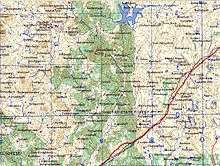
Savandurga is a hill 60 km west of Bengaluru (Karnataka, India) off the Magadi road 12°55′11″N 77°17′34″E / 12.919654°N 77.292881°E, in India. The hill is considered to be among the largest monolith hills in Asia.[1] The hill rises to 1227 m above mean sea level and forms a part of the Deccan plateau. It consists of peninsular gneiss, granites, basic dykes and laterites. The Arkavathi river passes nearby through the Thippagondanahalli reservoir and on towards Manchanabele dam.
History
Savandurga is formed by two hills known locally as Karigudda (black hill) and Biligudda (white hill). The earliest record of the name of the hill is from 1340 AD by Hoysala Ballala III from Madabalu where it is called Savandi. Another view is that the name is originated from Samantadurga attributed to a Samantharaya, a governor under Ahchutaraya at Magadi, although there is no inscription confirming this. This was the secondary capital of the Magadi rulers such as Kempegowda. From 1638 to 1728, Mysore took over this place and Dalavayi Devaraja occupied this place with the palace at Nelapattana. In 1791 Lord Cornwallis captured it from Tipu Sultan's forces during the Third Anglo-Mysore War.[2][3] Robert Home in his Select views in Mysore (1794) shows distant views of the hill from Bangalore.[4] He called it Savinadurga or the fort of death. There were no steps to reach the hill top and it was covered by bamboos and other trees forming a barricade.
Fauna
The hills are home to the endangered yellow-throated bulbuls and were once home to long-billed vultures and white-backed vultures. Other wildlife include sloth bear and leopard.
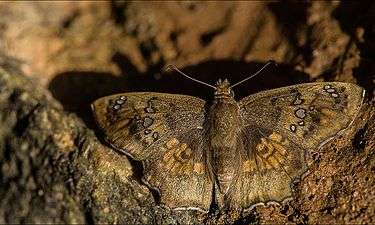 |
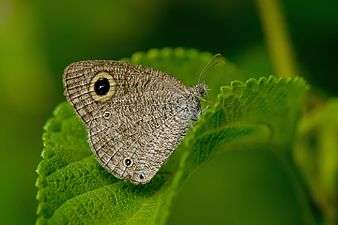 |
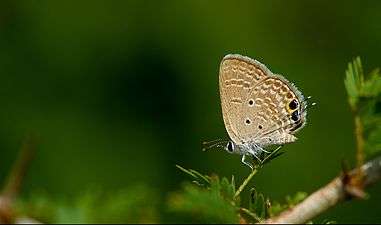 |
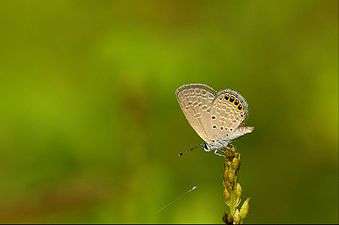 |
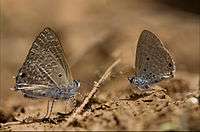 |
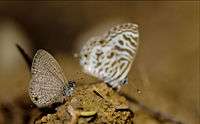 |
| Caprona ransonnetii | Ypthima asterope | Chilades contracta | Grass jewel | Pointed ciliate blue (left) and bright babul blue (right) | Common lineblue |
Flora
Surrounding the area is a state forest with scrub and dry deciduous forest covering 27 km2. The degraded forest, which is considered as shrub and tree savanna of the Anogeissus–Chloroxylon–Acacia series is highly diverse, recording over 59 tree and 119 shrub species. Some of the plant species recorded here include:[5]
- Abrus precatorius L. liana
- Abutilon indicum (L) Sweet. shrub
- Acacia auriculiformis A. Cunn. (ex Benth.) tree
- Acacia catechu Willd. tree
- Acacia chundra (Roxb.) Willd. tree
- Acacia concina (Willd) DC. liana
- Acacia farnesiana (L.) Willd. tree
- Acacia ferruginea DC. tree
- Acacia leucophloea (Roxb.) Willd. tree
- Acacia nilotica (L.) Del. tree
- Acacia sinuata (Lour.) Merr. liana
- Acacia torta (Roxb.) Bran. shrub
- Adina cordifolia (Roxb.) Bran. tree
- Alangium lamarckii The. tree
- Alangium salvifolium (L. f.) Wang. tree
- Albizia amara (Roxb.) Boiv. tree
- Albizia lebbeck (L.) Willd. tree
- Albizia odoratissima (L.F.) Benth. tree
- Albizia polycantha tree
- Annona reticulata L. shrub
- Annona squamosa L. shrub
- Anogeissus latifolia (Roxb.) Wall. tree
- Aristolochia indica Juss. shrub
- Azadirachta indica Juss. tree
- Bambusa arundinacea Retz.
- Barleria involurata Nees. shrub
- Bauhinia purpurea L. tree
- Bombax ceiba auct. tree
- Boswellia serrata Coleb. tree
- Bridelia retusa Spreng. tree
- Buchanania lanzan Sprengel. tree
- Butea frondosa Roxb. tree
- Cadaba indica Lam. tree
- Caesalpinia bonducella Fleming shrub
- Calotropis gigantea (L.) Dryand. shrub
- Canthium angustifolium Roxb. tree
- Canthium dicoccum (Gaert.) T&B. tree
- Canthium didymum auct. tree
- Canthium parviflorum Lam. tree
- Capparis sepiaria L. liana
- Careya arborea Roxb. tree
- Cassia angustifolia tree
- Cassia auriculata L. shrub
- Cassia fistula L. tree
- Cassia montana Roth. tree
- Cassia occidentalis L. shrub
- Cassia siamea Lam. tree
- Cassia surattensis Burm. shrub
- Cassia tora L. shrub
- Cassine paniculata (W&A) Romam. tree
- Celastrus paniculata (Willd.) shrub
- Chloroxylon swietenia DC., Prodr. tree
- Chromolaena odoratissima shrub
- Cocculus villosus DC. shrub
- Cycas religiosa tree
- Daemia extensa (Jacq) R, Br. shrub
- Dalbergia latifolia Roxb. tree
- Dalbergia sissoo Roxb. tree
- Dendrocalamus strictus (Roxb.) Nees.
- Diospyros montana Roxb. tree
- Dodonaea viscosa Jacq. shrub
- Erythroxylon monogynum Roxb. shrub
- Eucalyptus glabulus L. tree
- Eugenia jambolana Lam. tree
- Euphorbia antiquorum L. shrub
- Euphorbia thirukalli L. shrub
- Feronia elephantum Corr. tree
- Ficus benghalensis L. tree
- Ficus religiosa L. tree
- Ficus tinctoria Forst. tree
- Glycosmis pentaphylla (Roxb.) DC. shrub
- Gmelina arborea Roxb. tree
- Grewia hirsuta Vahl. shrub
- Grewia orientalis L. shrub
- Gymnema sylvestre (Retz.) Schultes. shrub
- Helicteres isora L. shrub
- Hyptis suaveolens (L.) Poit. shrub
- Holarrhena antidysenterica (Roth.) DC. tree
- Holoptelea integrifolia (Roxb.) Planch. tree
- Ipomoea carnea Jace. shrub
- Ipomoea repens auct. shrub
- Ixora polyantha Wt. shrub
- Jasminum pubescens Willd. shrub
- Justicia montana (Nees.) & ess. tree
- Kirganelia reticulata (Pior.) Baill. tree
- Lantana camara L. shrub
- Leptadenia reticulata (Retz.) W&A shrub
- Limonia acidissima auct. tree
- Murraya koenigii tree
- Murraya paniculata (L.) Jack. tree
- Ocimum sanctum L. shrub
- Olea dioica Roxb. tree
- Opuntia dillenii (K.G.) Haw. shrub
- Paramignya monophylla Wt. tree
- Passiflora foetida L. shrub
- Phyllanthus emblica tree
- Plumbago zelyanica Willd. shrub
- Plumeria alba Vent. tree
- Polygonum glabrum Willd. tree
- Pongamia glabra Vent. tree
- Premna tomentosa Willd. tree
- Pterocarpus marsupium Roxb. tree
- Prosopis spicigera L. shrub
- Pterolobium hexapetalum (Roth.) S&W. shrub
- Randia dumetorium (Retz.) Poir. tree
- Santalum album L. tree
- Sida cordifolia L. shrub
- Streblus asper Lour. tree
- Strychnos potatorum L.F. tree
- Tamarindus indica L. tree
- Tarenna asiatica (L.) Schumann. shrub
- Tecoma stans (L.) Kumth. shrub
- Tectona grandis L.F. tree
- Terminalia arajuna (Roxb. ex DC.) W&A. tree
- Terminalia bellerica (Gaertn.) Roxb. tree
- Terminalia chebula (Gaertn.) Retz. tree
- Terminalia paniculata Roth. tree
- Terminalia tomentosa (DC.) W&A tree
- Tinospora cordifolia tree
- Toddalia asiatica (L.) Lam. shrub
- Tylophora pauciflora shrub
- Vitex altissima L.F. tree
- Wrightia tinctoria R.Br. tree
- Wrightia tomentosa R.&S. tree
- Ziziphus mauritiana Lamk. tree
- Ziziphus oenoplia Miller. shrub
- Ziziphus xylopyrus Willd. tree
- Ziziphus zizyphus (L.) H.Karst. tree
References
- ↑ "Savandurga".
- ↑ Wilks, Mark. Historical Sketches of the South of India in an Attempt to Trace the History of Mysoor: from the origin of the Hindoo government of that state, to the extinction of the Mohammedan dynasty in 1799. Edited with notes by Murray Hammick. Mysore: Government Branch Press, 1930-1932.
- ↑ Anon. (1908). The Imperial Gazetteer of India. Volume 22. Oxford. p. 150.
- ↑ Home, Robert. Select Views in Mysore: the country of Tippoo Sultan from drawings taken on the spot by Mr. Home with historical descriptions. First publ. London: Bower, 1794.
- ↑ K. S. Murali, A. Kavitha, and R. P. Harish (2003) Spatial patterns of tree and shrub species diversity in Savanadurga State Forest, Karnataka. Current Science, 84(6):808-813
External links
| Wikimedia Commons has media related to Savandurga. |